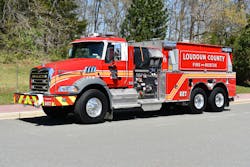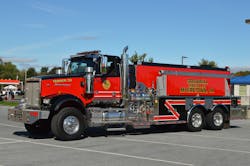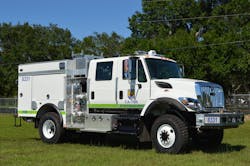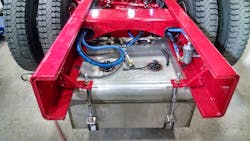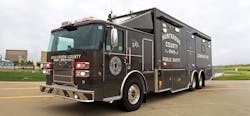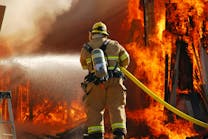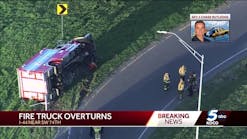There are many factors to consider when developing technical specifications for a new apparatus. These include: determining the mission of the vehicle, required fire-pump rating and water-tank capacity; staffing levels that will operate on the unit; and desired principal dimensions, including wheelbase and overall length and height.
Often, one of the more contentious decisions for apparatus specifiers is whether to utilize a custom fire chassis or a heavy Class 8 commercial model chassis, such as those that are built by Freightliner and International.Commercial advantages
There are applications where a custom chassis would be advantageous for engine company apparatus that’s associated with a crew size of more than four personnel, equipment that’s cab-mounted, shorter overall length and a fleet-replacement budget that’s funded adequately. Custom fire chassis generally are required for any type of aerial apparatus for which specific frame configurations are determined to be necessary to serve the community. Department pride in ownership is another factor that might need to be taken into consideration, along with the capability for servicing and maintaining the vehicle.
Over the past few years, the fire apparatus market has been dominated by custom chassis vehicles, while commercial chassis units make up approximately 40 percent of annual acquisitions.
All that said, Class 8 commercial chassis have a minimum gross vehicle weight rating (GVWR) of 33,000 lbs., which can have two or more axles. Historically, the fire service has utilized commercial chassis in both two-door and four-door configurations for pumpers, wildland apparatus, tankers and tenders. Furthermore, there are several areas in which commercial chassis excel when compared with custom chassis counterparts. From a financial standpoint, a commercial chassis that has a four-door cab and is equipped with a medium-block diesel engine costs significantly less than a custom chassis and can be serviced at the manufacturer’s local dealership.
Depending on the anticipated vehicle life cycle, parts availability for commercial chassis is more accessible when compared with some custom fire chassis. Commercial truck fleets rely on chassis and cab parts commonality to reduce vehicle downtime and provide off-the-shelf parts availability. Apparatus downtime can affect your response capabilities, particularly when insufficient spare or reserve vehicles are available. For this reason, Class 8 commercial chassis often are selected for these applications.
Many models of commercial chassis offer fire vocation options, such as integral front bumper extensions, cab SCBA seats, multiplex electrical system interfaces and a variety of diesel engine horsepower ratings. Several truck chassis manufacturers provide custom frame drillings that have specific component locations, such as crossmembers, air tanks and power take-offs, which reduce the extent of chassis modifications that are required by the apparatus body builder. Safety equipment, including frontal and side airbags, can be specified, as can dashboard layouts, which allow the driver to maintain eye contact with the roadway at all times.
When compared with custom fire chassis, where each vehicle is highly customized to meet a fire department’s requirements, the commercial chassis market depends on platforms that are designed as base models and that have numerous pre-engineered options that can be utilized to meet the customer’s needs.Advanced technology
Because commercial fire chassis stem from the larger heavy-truck industry, commercial fire chassis manufacturers lead the way in advanced vehicle technology, particularly with respect to reducing vehicle downtime and monitoring chassis functions via telematics, compared with custom fire chassis suppliers.
Regarding telematics that are included on commercial chassis, the major chassis functions are monitored, including preventative maintenance schedules and engine performance to maximize fuel economy.
Many commercial truck vocations, including construction, utility, highway and delivery—along with fire departments—experienced issues in conjunction with the early phases (2009–2013) of the then-new mandates on diesel engine emission components that were brought by the Environmental Protection Agency. Many fire departments experienced long out-of-service times while engine suppliers and body builders worked through engine-regeneration problems. Both commercial truck chassis manufacturers and fire apparatus builders have worked to address vehicle reliability.
Most fire apparatus manufacturers established relationships with the major commercial chassis dealerships in their respective locations. This provides access to their chassis specification system and body builder guides. Each chassis manufacturer maintains its own software system to develop a detailed chassis specification and performance scans to confirm vehicle gradeability, acceleration and turning-radius data. Reviewing this material can be problematic at times; however, with the assistance of local sales engineers, the methodology and details that are provided within the chassis component list, detailing all equipment being provided, can be discerned and easily understood by members of the apparatus committee.
Annually at the Work Truck Show, which is convened by NTEA–The Association for the Work Truck Industry, each of the truck industry chassis and component suppliers introduces new products and technology to enhance vocational fleet reliability. Over the past several years, many of the advances have been in the area of driver safety and reduction of out-of-service time. Fire department fleets are particularly sensitive to the ratio of in-service to spare or reserve apparatus, which can be rapidly placed into service while front-line units are undergoing preventative maintenance or addressing warranty concerns.
Several Class 8 truck manufacturers designed their chassis frame rails with a single, heavy-duty rail for use in the snowplow and utility vocational markets. The single rail reduces frame corrosion that’s common to double-channel frame rails and those that require a frame liner. In many areas of the country, fire apparatus is susceptible to frame corrosion in the areas of crossmembers and bracket attachments, and the corrosion can go undetected without routine frame washing that uses solvents to remove road salt and chemicals.Bid advantages
There are several advantages to specifying a commercial chassis when developing specifications for a new apparatus. The department can meet with sales representatives of several chassis builders to review requirements and to compare cab and chassis components, features and costs. This analysis would enable the apparatus committee to determine the best value to meet the mission of the new apparatus prior to the formal bid process. In addition, if one or more chassis are deemed to be acceptable, these specific models can be supplied by any apparatus body builder and would not restrict competitive bidding.
Once the bids are received, the review process can be somewhat easier than otherwise, as the chassis configuration and option content should be similar from each of the body builders. The committee should review the requested terms of payment with respect to the chassis, because many apparatus manufacturers require payment for the commercial chassis when it’s delivered at their facility.
Should the department be in a position to make the chassis payment, there are two guidelines that should be followed and incorporated into the department’s bid documents. First, once payment for the chassis is made, the Certificate of Origin should be transmitted to the department to be covered by its insurance policy. Second, the bid documents should require the apparatus manufacturer to provide a Performance Bond to secure the fire department’s financial interests through the manufacturing and final acceptance process.
Cost-to-needs ratio
When developing specifications for new apparatus, consider how commercial chassis might be utilized to provide a cost-effective alternative to custom fire chassis to meet your department’s needs. In many cases, the Class 8 commercial chassis can be specified with chassis, drivetrain and safety components to provide a well-designed vehicle for use in structural and wildland fire protection. That said, in all respects, the completed apparatus must meet the needs of the response district while providing all available safety equipment, including stepping surfaces and passenger restraint systems (to meet all of the vehicle-specific requirements of NFPA 1901: Standard for Automotive Fire Apparatus). Your personnel deserve nothing less, and meeting these goals will ensure that the new apparatus will provide the required years of front-line service to the department.
